And here are the back feet (WITH solar shots)
The bber previously known as 5mgn…
“The sweetest of all sounds is praise.” --Xenophon
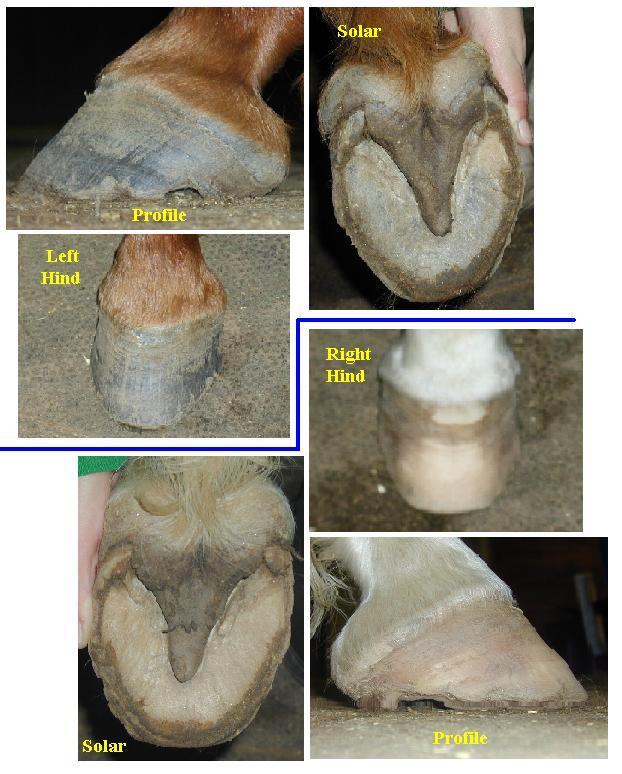

And here are the back feet (WITH solar shots)
The bber previously known as 5mgn…
“The sweetest of all sounds is praise.” --Xenophon

He was wiggling. Here are both rear again…
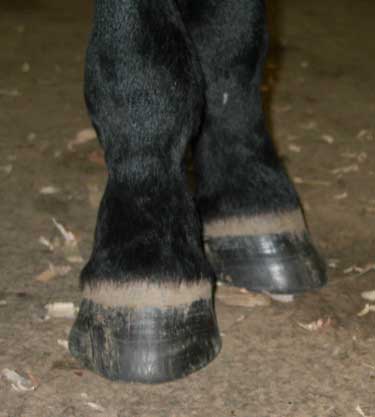
<BLOCKQUOTE class=“ip-ubbcode-quote”><font size="-1">quote:</font><HR>Originally posted by slb:
The reason they continue is that they are instructed that shoeing and traditional trims (whatever that means) have damaged the inside of the foot (even if it isn’t that evident on the outside) to the point that it will take 1 or more years to completely heal.<HR></BLOCKQUOTE>
Ok…here’s the funny thing: We have a “Strasser Follower” at my barn. Her horse has a rotation in the right coffin bone, and she is convinced this will “fix” him. Well, I pulled the shoes off my pony this winter, because he was on Vacation while I concentrated on my three year old. The pony is sound as a dollar. Here’s the kicker: She says to me the other day "she noticed bruising on the pony’s back feet (he has pink backs) and this is because of the hoof being able to “heal itself” without the damaging shoes.
I just smiled and nodded, as she was pointing out all of the “healing” going on in his little hoofs.
Guess what? This pony NEVER had back shoes on in his life! All the “healing” without shoes musts been spontaneous from just removing the front shoes? All I know is her horse is still dead lame after 9 months of this – and the blacksmith actually had him sound with pads and a heartbar shoe.
>>It’s not bragging if you can back it up!<<
Nope,not disappointed at all! I’m just amazed at your wealth of knowledge! ![]() You put alot of thought and effort into your responses. (I was betting you were a vet)
You put alot of thought and effort into your responses. (I was betting you were a vet)
I’m going to snap Rhodey’s pics tomorrow morning. An update! Libby, his eggbars do trail behind (one of the important reasons they must always be in bell boots), but I understand the farrier to mean they also supported the bony column and were the best option when you were trying to realign it.
Robby
“Don’t mince words, don’t be evasive
Speak your mind, be persuasive”
Madonna
Oh no, you guys let this slip on to the second page… ![]()
Bump…
Proud member of the * Hoof Fetish Clique *
I don’t want to be a pest, but please don’t forget to check out Zephyr’s photos, that I posted on page 20. When y’all get a chance, that is. ![]() (I know you’re busy.)
(I know you’re busy.)
Okay, I have pictures. This might take a few posts so bear with me.
For those of you who have tried photographing your “babies,” I now know how you feel. Mr. Wiggle Worm did not want to stand still. Thank goodness for digital cameras. ![]()
[This message was edited by shadytrake on Mar. 27, 2003 at 09:54 PM.]
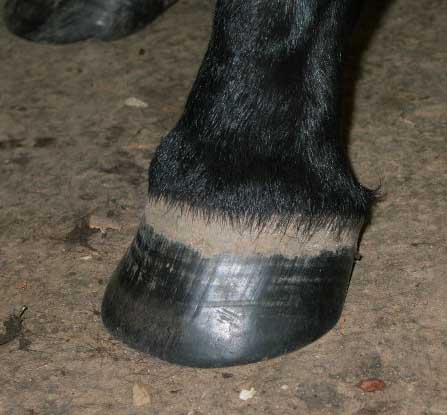
Hey kids…found this interesting article on trimming to the live sole plane/high heels at the AFA site. This will be of interest to those who have underrun heels, dished toes, and parallel hoof walls/pastern angles.
Uniform Sole Thickness. Oh well, everyone has to have their own name for stuff. otherwise it wouldn’t be their unique idea ![]()
Proud member of the * Hoof Fetish Clique *
slb, I’m a little confused. You refer Lisa to the hopeforsoundness site and talk about horses in the wild and how they wear their feet. Ozzie has been barefoot his entire life, and lives in what is probably a semi-wild environment (he’s on 24/7 turnout, I’m pretty sure), so why aren’t his feet more like the feral horses studied by the New Balance folks? Lack of extreme conditions/changes (like going from rock to steppe to plains?)?
I’m just curious as to how his trimmed hoof can look basically like what we’re all hoping to change about our shod horses.
Robby
“Don’t mince words, don’t be evasive
Speak your mind, be persuasive”
Madonna
<BLOCKQUOTE class=“ip-ubbcode-quote”><font size="-1">quote:</font><HR>Originally posted by slb:
Well…they don’t exactly shoe to promote underrun heels…they shoe to promote long toe, the heels just follow!
Old track tradition dictates that horses run better with long toes…short breakover shortens stride, long breakover lengthens stride. But, as we have discussed here…point of breakover is not at the end of the toe, it is at the end of the coffin bone. Additionally, enhancing breakover can create many things…it can either lengthen or shorten stride, depending on how it is addressed and what the intent is.<HR></BLOCKQUOTE>
sigh well THAT explains a lot. Thanks to this thread, and some other reading I’ve been doing, I’ve been quite disturbed by how long and un-balanced my horse’s feet are. They seemed “normal” to me because it seems that MOST of the horses around here look that way, and all 4 of the farriers I’ve used in this area have trimmed that way. No wonder so many horses around here are navicular!!
Turns out the farrier I’ve BEEN using for the last 2 years does a lot of track horses. DOH!
I’m so desperate to fix my horse’s feet that I’m flying a farrier in from the other end of the coast.
My horse has long toes, narrow solar views, heels tending to under-run, and wind-puffs in his hinds. My trainer’s horses had wind-puffs, too, that went away with the new farrier. I have a sneaking suspicion that his stifles will straighten out a bit, too.
Hi,
I’ve been a long time lurker at the BB (since I read it at work), and have been following this monster thread on and off.
My 15 yo Tb mare normally has (I think) fairly decent feet. I’ve been struggling with two farriers over the past year to work on getting her to have more heel. I’d finally been making progress when, about 3 weeks ago, we moved barns. Now my mare’s feet are falling apart.
http://photos.yahoo.com/bc/sarahbj100/lst?.dir=/Duchess+feet+06-14-03&.src=ph&.view=
Sand arena, sand turnouts, and hard ground on trails (didn’t keep that up for long) are sucking moisture out of her feet. They’re chipping up like crazy. We came from a barn with no outdoor, no trails, and t/o in indoor arena. So, presumably, her feet need to get used to it. In the 9 years I’ve had her, she’s never had a chipping/crumbling problem, even when in similar footing conditions. I’m applying Rainmaker and plan to have the shoer put hind shoes on.
She was last trimmed/reshod on May 8th. I’ve had her on a 7 week cycle throughout the spring. Toward the end it is more noticable that her two fronts grow at slightly different angles. However, about a week ago (just over 4 weeks from last shoeing), she started looking like her LF was falling off her heel. It has continued to look worse and worse. Her shoe has also twisted slightly, and she’s taken a chunk out of the wall on the inside (can’t see it in the pictures).
I’m particularly concerned about the collapsing heel/increasingly long toe/poor angle because she had a slight suspensory strain on that leg a year and a half ago. I was living overseas, she was leased out. I suspect that her shoeing wasn’t great (long toes and low heels) and aggravated by being turned out in deep mud.
I’ve been trying to get a shoer out to do her sooner, but have been unable to find someone to come on short notice. My shoer doesn’t come to my new barn, so I’m callng up new shoers (understandable that they won’t rush around for a new client). My new barn’s primary farrier can’t even get to her until Thursday.
I’d be curious in general what you all think about her feet. Any recommendations for dealing with the new dryness? Any recommendations for shoeing (since I’m starting with a new shoer it’s an easy time to bring up concerns)?
We do lower level dressage, going to start doing some jumping, and hope to trail ride a bunch this summer.
Let me know if there’s any other information I could provide.
Thanks!
MsDuch
And the next one…
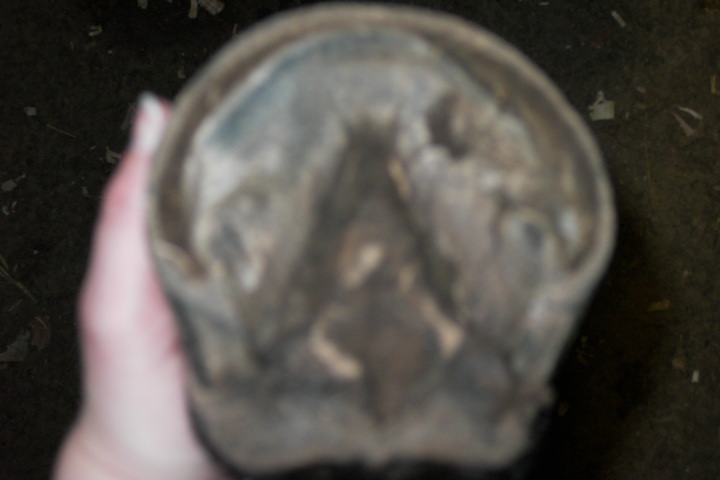
Debbie…I hope that was a promise and thanks for the words of support.![]() Yep…Bensmom (and some others) have been great throughout this thread…don’t think that I have ever had to think so hard about answering questions.
Yep…Bensmom (and some others) have been great throughout this thread…don’t think that I have ever had to think so hard about answering questions.
Big Thanx to Martha for starting it! It’s the longest and best foot thread that I have ever been on…and with little disagreement ![]() Not saying I want everyone to agree with me either…and would enjoy the mental exercises involved in debate. But, discussion is just as helpful and generally less emotional.
Not saying I want everyone to agree with me either…and would enjoy the mental exercises involved in debate. But, discussion is just as helpful and generally less emotional.
COTH forum rules ![]()
Proud member of the * Hoof Fetish Clique *
<BLOCKQUOTE class=“ip-ubbcode-quote”><font size="-1">quote:</font><HR>Originally posted by NRB:
Thanks for the speedy reply martha. I had also thought that the frog was to come into contact with the ground to “pump blood” into the hoof area.<HR></BLOCKQUOTE>
Hi NRB, glad you joined us and brought such a good question. I’ll try to add to Martha’s comments and clarify why there is so much confusion. The “pump blood” theory is still a confusing and controversial issue. However, according to recent research at Michigan U (Bowker), when the frog comes into contact with the ground it increases circulation in that it improves action in the digital cushion. The digital cushion is a key structure that supports the rear of the coffin bone and absorbs concussion. It also is the one structure that suffers the most damage from poor trimming and shoeing. The problem is, with it being internal, it is often overlooked and the importance of its health ignored. It is thought that lack of health in the digital cushion could be the reason for several undiscovered lameness issues.
<BLOCKQUOTE class=“ip-ubbcode-quote”><font size="-1">quote:</font><HR>But this one book, the Cherry Hill Maximum Hoof Power, states that is a myth. Increased activity pumps blood from the heart through the limbs. The frog is not a second heart or so this book claims.<HR></BLOCKQUOTE>
This statement is true to a degree. Most would not dispute the importance of increased movement playing the biggest role in increasing circulation…especially in the feet.
<BLOCKQUOTE class=“ip-ubbcode-quote”><font size="-1">quote:</font><HR>The book furhter states “It is not necessary or desirable for the frog to bear weight when the horse stands on level ground.” pp48.<HR></BLOCKQUOTE>
Wild horse studies compared to improved health in domestic horses and studies of such, have now proven this untrue. Bowker, Ovnicek, Jackson, and many others have found that the frog must touch the ground to improve health in the foot. If this doesn’t happen, often the frog will over compensate and try to grow down to touch the ground. Ovnicek’s EDSS system of therapeutic shoeing is based on frog pressure theories and is highly successful because of it. If the frog deteriorates because it is not retaining its elasticity and health (due to lack of ground contact), then the digital cushion suffers. If this happens, the whole foot suffers.
<BLOCKQUOTE class=“ip-ubbcode-quote”><font size="-1">quote:</font><HR>ALso the book said the “short walls casuses the sole to bear weight.” and that “the (hoof) wall can wear so excessivly (when barefoot) that the horse is walking on his soles. This often results in sole bruises and sole abcesses.” pp 18.<HR></BLOCKQUOTE>
Noone can deny these statements…however, are these things beneficial or are they harmful? A seminar at Tufts U last year presented Strasser’s trim (see previous posts early in thread) for peer review. The panel of farriers, vets, and a barefoot trimmer all questioned that Strasser’s trim leaves the wall as a primary weight bearing surface. They all disagreed and indicated that the sole should play a part in weight bearing also. (See Hoof Care and Lameness Magazine…Strasser trim link off the front page…for more info on what they felt was wrong).
Ir is very true that in a hoof without sound internal structures, with a thin sole, or with the coffin bone tipped or sunk (from high heels or founder) that excess pressure is placed upon the sole corium from within…with additional pressure on the sole from outside, bruising is generally severe and difficult to resolve. However, if the hoof capsule is balanced and the coffin bone is in correct alignment, then the sole will generally thicken to protect the sensative structures and no bruising will occur.
<BLOCKQUOTE class=“ip-ubbcode-quote”><font size="-1">quote:</font><HR>So since the farrier had me use Venice Turpentine on my horses soles because they were so thin, I was assuming, that after reading this, my horse with thin soles, wet weather, low heels and short to no hoof wall leaving the frog exposed to bear weight, I was doing my horse more harm than good by leaving shoes off his hind feet.<HR></BLOCKQUOTE>
I am not convinced that putting anything on the sole actually helps much…except that it drys it out…so, if overly wet, that may be a help, but could also be a hindrance. In the case of your horse’s frogs, there could be a couple of general reasons for it being overly large. It could be robust and well functioning. It could be trying to protect the foot from imbalances that casue pain, loss of integrety, or improper function and therefore it becomes overly large as a case of protecting the foot. The final reason is that heels are really too long, not too short (if they are underrun…generally they are too long, but appear short) and the foot may be contracted. In some feet the frog makes an effort to touch the ground to help repair the problems realted to contraction and underrun/overly long heels. It is very easy to believe that a foot is healthy when it has high heels and contraction. The reason being that it does “seem” to meet the criteria for a good hoof: concavity, robust frog, apparently short heels. The reality is that the concavity is excessive from the heels pushing in on the cadual structures. The frog is becoming enlarged in an attempt to heal itself. And the heels are long, just growing forward rather than downward.
Proud member of the * Hoof Fetish Clique *
Hey this was getting shuffeled way back in the pack here… ![]()
“Proud Member Of The I Love Dublin, Starman Babies, Mini Horse, Sunnieflax and Horse Boxes Cliques”
[small voice]IMHO, Robby’s photos are not at the same angles nor similiar enough to each other in other respects to truly judge the before vs. after photos, nor is either photo at the right angle to judge the hoof correctly in it’s own right for the state of it for each photo. [/small voice]
Two Toofs
(formerly - but still - NDANO)
Check out the online trim/shoeing tutorial at Hope for Soundness web site. They also sell a video that goes with it, a nice booklet that has some great pics to illustrate their information and a DIY trim guide video that they just released. Generally, the trim info is very helpful to most farriers.
Forgot the what you can do part…if you just get a rasp and keep rasping off the flares and keep the heels (where the wall turns into the bars) rasped down so that they are as close to the widest part of the frog (where the straight edge of the frog starts to turn into the rounded part) as they can be. That will help a lot. The progress will be slow, but it will happen.
Also…don’t think I explained that the long toe is simply a “flare” treat it that way. Keep it backed up to the white line. Also, check out in the trim tutorial how they rasp from the toe calous upward across the toe to enhance breakover. This is a primary key to getting the form back.
Proud member of the * Hoof Fetish Clique *
[This message was edited by slb on Mar. 06, 2003 at 04:14 AM.]
left hind
— And how did you feel about being denied these Hungry Hippos?
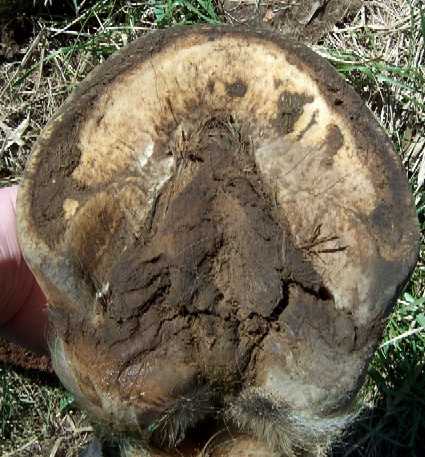
<BLOCKQUOTE class=“ip-ubbcode-quote”><font size="-1">quote:</font><HR> I think that there are two big differences between “natural” methods and “traditional”. <HR></BLOCKQUOTE>
Ah, I think where I wasn’t clear was that I wondered if “natural” methods, and the theory of shoeing to the x-ray revealed angles weren’t actually quite similar, rather than comparing “natural” and “traditional” methods. This is what I understood that “natural” methods were doing:
<BLOCKQUOTE class=“ip-ubbcode-quote”><font size="-1">quote:</font><HR> . While the “natural” methods…at least Ovnicek’s and a couple of others…seem to look to the outside for landmarks to help determine correct form, those landmarks are really indicating where the coffin bone resides in the foot, as well as some other internal structural details. <HR></BLOCKQUOTE>
So, we really are talking about the same thing – they, at least the ones you have mentioned, are looking at external landmarks to ascertain the angle of the phalengeal lever, rather than always using x-rays, though as you also point out, some also use x-rays.
What I thought was interesting was that Stovall’s article seemed to be negative on all “natural” methods, when at least some are doing exactly what he says is the only way to do a horse’s feet – getting p1/p2/p3 in correct alignment.
<BLOCKQUOTE class=“ip-ubbcode-quote”><font size="-1">quote:</font><HR> For some reason, optimal form creating optimal function does seem to be some strange concept to many professionals. “Why” is the question of the decade. I have no idea. <HR></BLOCKQUOTE>
Me either, in fact, I am so frustrated right now, I feel like just giving up. <see below>
<BLOCKQUOTE class=“ip-ubbcode-quote”><font size="-1">quote:</font><HR>Don’t get me wrong Bensmom…I am not that down on your farrier. I may say some harsh things, but I feel that he is doing the best he can to try and gain an understanding and help your horses. We don’t all come to the table with the same skills and knowledge…if we did, there would be no discussion and we would stagnate <HR></BLOCKQUOTE>
Ok, warning, vent ON. You may not be that down on my farrier, but I’m not happy at the moment. I KNOW I’m not a vet, nor am I a farrier, but I am so darn tired of defending what I know to be the right way of caring for my horse I could scream.
He refuses to let go of the idea that since my horse lands outside edge of hoof first on his back feet that he is higher on the outside than on the inside and that the flare on the outside of the hoof also absolutely, without doubt means that he is unbalanced m/l with the outside higher.
This is wrong. I have radiographs that show his p1/p2/p3 tilt to the outside. There is clinical evidence that while he was on stall rest, and I wasn’t riding him to catch the difference and he was being trimmed the way the farrier thought was correct, he became totally unable to canter at all, and yet, when he was trimmed in the way I insisted on, he was back able to step under himself. I got down on my hands and knees under the horse yesterday with a measuring tape and made a concerted effort to check, at the same points on the back of the foot, inside and outside, hairline to ground, and he was almost .5 inch higher on the inside of his foot. I can see it with just my naked eye!
He argued with me yesterday, basically in a teasing manner, but with a bite to it, and I can tell he seriously disagrees with me. He had no answer for why all the hard evidence agrees with me, and nothing backs up his opinionn other than he swears absolutely that the edge of the foot that lands first as the horse steps is the higher one and the same thing with a flare – that it only flares on the side that is higher.
This would be true in an ideal situation, i.e. if the hoof had no bones within it, or above it, causing it to tilt differently and strike unevenly.
If it were just a dispute, and I had the knowledge to tell him precisely what I wanted, it would be one thing. But, it isn’t. He really resents the fact that I disagree with him, and it has affected my horse. He wanted to pack his contracted heels in the front with cotton to soak with thrush medication last night – I know better – the times we have tried this, he goes lame from any pressure there. But, I was so intimidated that I didn’t argue with him. Guess what? He was lame right front. Thrush is an ongoing problem with his problem feet – as soon as it rains, I have to be very diligent, and since he is poured in front, I don’t think to check all that often and I missed it. During the summer I just have to remember to medicate it preventatively and I hadn’t started yet.
In addition, for some reason he also ended up lame on the right rear, for which we had no explanation, other than perhaps he was cut too short there in an effort to satisfy my request to lower his inside. The farrier did pull a nail that he didn’t like and didn’t replace it, so perhaps he quicked him.
I am so frustrated. I cannot switch farriers, as this one is the only one in the area that I have a prayer of getting to do a good job on my horse. At least he has the mechanical skill to do what I need done, and I CAN talk to him, most of the time. The other two in the area that have the skill to do my horse 1) won’t take him as he has a reputation for having difficult feet (he has been the subject of the farrier’s monthly breakfast meeting more than once) and 2) would never allow me to ask questions/make suggestions, so that would be right out.
Probably the best thing for me to do would be to figure out a way to disprove my farrier’s main two assumptions about how the foot lands, and I’m not sure I know how to go about that.
Any ideas?
Libby (who came close to losing it when her horse was sound prior to reset and lame on 2 of 4 feet afterwards. argghhhhhh)
Proud member of the Hoof Fetish Clique